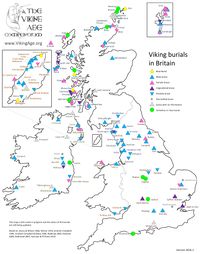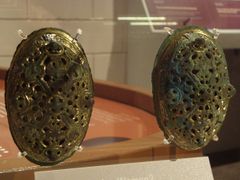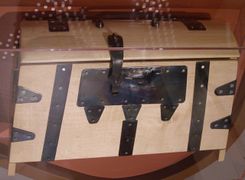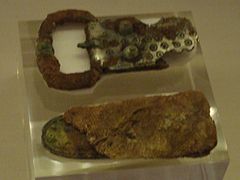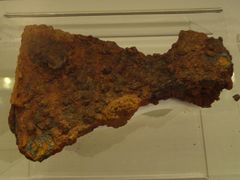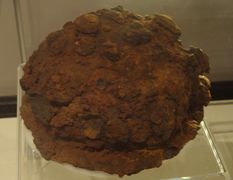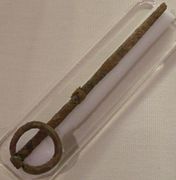| Viking burials found in Wales |
|---|
|
This list of burials is currently a work in progress. More information will be added over time but it is hoped that even the meager information supplied here will be of some use. Any list of Viking burials is going to be open to discussion. Many of these burials were discovered in the 19th century, long before modern archaeological practices came into use.
The map is derived from Richards [Richards 2004:p.191] Graham-Campbell [Graham-Campbell 1994:p.134, 153] and from a map displayed from a Jorvik exhibition in York 2012.
Viking burials found in England
Viking burials found in Scotland
Viking burials found in the Isle of Man
Status
The reliability of pagan graves varies. The 'Status' rating gives an indication of the current thinking relating to the finds reliability.
Accepted (A)
There is a good contemporary archaeological record of the find. Including a diagram of the grave and finds, etc.
Possible (P)
The contemporary archaeological record of the find is not as good but the grave goods would tend to indicate a pagan grave. The grave may be located in a mound or Church yard.
Discredited (D)
The argument in favour of this being a Viking grave has now been discredited although it has previously been published as such in the past. These are most probably just stray finds.
List by Find Date
England, Lincolnshire: Torksey
- Part of a group of winter camp sites of the Great Heathen Army:
- Torksey 872-873AD
- Repton and Heath Wood, Ingleby 873-874AD
- Status- Accepted
- Type- Mass burial
- Find date- Excavated in 2011
- Bodies-
- Dated to- AD 872-873
- Museum-
- Publications-
- Grave goods-
England, Dorset: Weymouth
- Status- Accepted
- Type- Mass burial
- Find date- Excavated in 2009
- Bodies- up to 54 decapitated males
- Dated to- 970-1025AD
- Museum-
- Publications-
- Grave goods-
- None
England, Cumbria: Cumwhitton
- Status- Accepted
- Type- Burial
- Find date- Excavated in 2004
- Bodies- 4 men and 2 women
- Dated to- AD 900-950
- Publications-
Grave 1. Female
- 2 oval brooches- type P51
- 1 glass bead (near skull)
- small knife and iron key (near waist)
- iron-bound wooden box - containing:
- lead spindle whorl, glass linen smoother, shears, antler comb, sewing needle, possible metal needle case
Grave 2. Female
- belt: buckle with plate - tinned copper alloy, and strap end - copper alloy. (near waist). Traces of seal pelt found between the plates.
- necklace: 6 glass beads, 1 chain-link - copper alloy. 2 other beads were also found any may have belonged to the necklace.
- finger ring - oil-shale
- arm ring - oil-shale
- chain-link - copper alloy (near waist). Possibly part of a suspension strap for a drinking horn along with the other chain-link identified as also being part of the necklace (Paterson 2014, p.72)
- drinking horn mount - copper alloy and fragments of horn.
- sickle, shears, antler comb (found together)
Grave 3. Male
- ringed pin
- 6 glass beads, 1 amber bead, 2 silver finger rings, 1 silver suspension loop (near neck). May have been in a bag or a necklace
- sword - type U
- knife
- folding knife (near waist)
- whetstone (near waist)
- 2 buckles and strap slides (near foot). For spurs
Grave 4. Male
- belt: buckle with plate - copper alloy, and strap end - copper alloy
- ringed pin
- glass bead
- sword - type L. remains of scabbard including traces of a small buckle
- spearhead - type K, with part of wooden shaft - ash
- axehead - type E, part of haft - boxwood. possibly butt hafted
- shield boss - R564/R562, estimated 80-95cm shield diameter
- possible strike-a-light
- knife
Grave 5. Male
- buckle with plate - copper alloy, and strap end - copper alloy
- pair of iron prick spurs, with attached plates. Also with an associated buckle and strap guide.
- a glass bead and an amber bead (near neck)
- sword - type X, and scabbard - sheep lined, poplar or willow wood lathes, covered in leather
- 2 strap ends - possibly part of a sword baldric or possibly a 'peace tie'.
- spear - Type K
- Seax with a silver inlaid horn handle and some traces of the leather sheath, along with copper-alloy binding strips
- drinking horn rim mount (near head)
- folding knife
- flints, a silver coin, a glass disc, a knife, and a ringed pin (near left hip). possibly all in a pouch
- iron chain
Grave 6. Male
- buckle with plate - copper alloy
- spearhead - type G but with a longer socket and no mid rib
- knife with horn handle
from the plough soil
- oval brooch - maybe belonging to grave 2
- buckle - copper alloy - maybe belonging to grave 1
- ringed pin - copper alloy - maybe belonging to grave 6, or even graves 1 or 2
- large amber annular bead
- 4 glass beads
- sword - type L - maybe belonging to grave 6
- spearhead - too damaged to type
- spearhead - type I
- spearhead - possibly a type G
- possible seax
- key - copper alloy
- possible antler comb
- possible folding knife
- possible folding knife
- knife blade
- spur fragments
- buckle - iron
References
